—Samuel Johnson
My guess is that Canon cameras were used to photograph the 2008 Victoria's Secret Fashion Show.
Note that the site is in Russian, but that doesn't really matter as the subject matter is universal.This journal documents my experiences with a Canon EOS 50D camera. It is also a showcase for my photography, including comments about the camera's usability, with suggestions for improvement and discussions about various photography-related topics.
My guess is that Canon cameras were used to photograph the 2008 Victoria's Secret Fashion Show.
Note that the site is in Russian, but that doesn't really matter as the subject matter is universal.Superb black and white photography and portraits of celebrities (including Einstein) by Ernst Haas.
His behind-the-scenes photographs on the set of The Misfits are the last memorials to Marilyn Monroe's career.
Other than the first photograph in the series, I can't say I was impressed with his photographs of Audrey Hepburn's wedding; the photos have a distant quality, rather than an intimate quality to them.
His colour photography is breathtaking in framing (see "Locksmith's Sign" in the New York series), composition and contrasts— he makes photography look so easy.The Moon. Shutter Priority 1/640s, f/1.4 [1 of 15]
A few weeks ago, just before bed, I happened to take a look outside my window, just before getting into bed when I noticed that the sky was clear and the moon was out— I just had to take some pictures.
Before getting dressed, I checked my journal entry where I recorded the camera settings for the last lunar eclipse I had photographed. I then got dressed and hopped out onto the balcony with my 50D and began photographing the moon. I leaned the camera on the balcony railing for stability, but because of the distance and my 50mm lens, even the slightest vibration like the shutter clicking added jitter to the photograph.
As I was coming back in, I bumped the base of the camera on the sliding door quite severely (if it had been a piece of wood, it would have nicked the wood). Once inside, I carefully checked the body of camera for a dent or a paint bruise— nothing, not even a scratch— phew!.
Update Wed Dec 03 15:54:47 2008: I was re-reading the manual last night and I realize I should have changed the metering mode from Evaluative to Center-Weighted as the subject I am photographing is in the center, and surrounded by blackness.
Update Sat Dec 06 20:17:04 2008: I was taking some night photographs of the freshly fallen snow and playing with the metering modes, I found that Partial Metering produced better exposed photographs (at -2/3 EV).
After a month of using the camera, I have to retract my statement about the top-side LCD being "old school". I have found the top-side LCD handy when needing to quickly change the AF modes between One Shot, AI Focus and AI Servo.
The alternate way to change the focus mode, is to use the rear LCD via the QuickControl menu (after pressing the joystick).Beautiful models, beautiful, hair, beautiful makeup, beautiful clothes, beautiful lighting— all the ingredients (plus a good camera and lens) necessary for beautiful fashion photos (without beautiful clothes, the photographs become erotica).
My guess is that she uses a Nikon.
If you look at the model's eyes in the closeup photographs of the third shoot, you can see the photographer's lighting rig.
Her black and white shoots are also superb.Both the bench and the war memorial look better after having been converted to black and white. For some reason, the reflection of the train windows onto the concrete is more prominent in the thumbnail than on the actual photograph.
The parking lot signs look good in both modes. The VIA Rail sign looks a bit better in colour. The contrast has been tweaked on some of the photos.Stunning black and white photography of the animal kingdom from Nick Brandt. Try to guess the lens he's using for each photograph.
Black and white photography is my holy grail. I see the world in colour, not as shades of light and darkness. One exercise I perform when I review my photos, is to preview them all in black and white, just to see how they would look— there are some that I think will look great in black and white, but they don't; then there are ones I don't expect to look good, but they look surprisingly good.During some housekeeping on my Mac, I found a New Yorker magazine ad from the 70s (I didn't note the issue) for Polaroid Land (I assume it means "landscape") Cameras, ranging in price from $200 for the top-of-the-line camera with a f/3.8 lens and 1/500s shutter speed (top right), down to the $25 el cheapo (bottom left).
After a suggestion by a faculty member, I am considering the Canon EF 17-40mm L wide-angle lens. Pricing is quite varied:
The reviews are very favourable, as is the comparison with the Canon 16-35mm f/2.8L (twice the price for twice the light). The primary advantage over the 24-70mm f/2.8L is the weight (approx. half) and the wider angle.
He also suggested that I could likely negotiate it down to $700, or if I waited until Boxing Day, I could avoid the sales taxes. My lack of people skills make negotiations impossible and I have a low tolerance for shopping-frenzy crowds.
I am hesitating on the purchase because I prefer a versatile lens— usable both indoors (meaning faster than f/4) and outdoors and I prefer a prime (less glass means more light). Canon's wide-angle prime lenses, however, are quite "sucky".
Update Sat Nov 22 16:15:07 2008: David responds with some suggestions:
What's your budget? Canon has a 24 mm f/1.4L for $1300, with a less expensive f/2.8 at $500. 28mm f/1.8 and f/2.8 can be had for $600 and $300. I don't see the half-stop going from 1.8 to 1.4 being worth $700 IMHO.
Gruber shoots (only) with 50mm and 28mm, both f/1.8.
Note that once you get into the f/3.5 range getting any kind of bokeh is difficult at these focal lengths. You probably want to stay below f/ 2.8 if you want any meaningful blur.
Remember that you'll replace your body before you replace your lens, and if you ever stop being interested in photography, lenses don't depreciate as much as bodies.
My budget is virtually unlimited, but at this early stage, I refuse to buy a lens that cost more then the body ($1400) just as a sanity check— I don't want to buy optically fantastic lenses that collect dust at home.
Eventually, I want a (indoor/outdoor) wide-angle lens (24mm or less), a 50mm (I'm happy with my f/1.4 USM) and an indoor sport lens— 85mm (f/1.8 or f/1.2L) or 100mm.Sample photographs with Jim's lens at 28mm. My verdict: this is an outdoor lens; indoors, in low light, it delivers blurry photographs unless using 1600+ ISO.
Jim brought his EOS3000 and I got a chance to use his EF 28-80mm f/3.5-5.6 II lens which was the camera's kit-lens.
The wide end (35mm equivalent at 1.6x), is a deep breath of freedom when compared with my 50mm (80mm equivalent at 1.6x). However, being used to shooting at f/1.4 indoors this lens takes some getting used to. Today was a pretty bad day to test this lens outdoors as it was mostly overcast. In general, I would say this lens lacks crispness.
A motorized tripod is available, for mounting DSLRs, for gigapixel panorama photographs.
Some more desktop backgrounds (I have configured my Mac at work to rotate them every hour and my Mac at home to rotate them after every wake from sleep).
I found the originals dull and boring (through no fault of the camera; it was the lighting in the store) so I tweaked the settings to make them more delicious. The green beans need a lot of "healing" as the bit of sugar, visible as white spots, are too distracting at such a close distance. Perhaps if I had stood further away...
I'm sure you will agree that the adjusted images look better than the originals.The previous night, I played with the camera in Manual mode and learned about the light-meter and what happens if you ignore it. So, here are the steps (I have used) to take a photograph in Manual mode:
The conditions you want before you can take the shot are: first, for the light meter to be centered at 0 and second, for a shutter-speed that is fast enough to capture your photograph.
So, being used to taking photographs where the camera is ready to shoot in under 2s, you can image why I thought shooting in Manual was so terrifying, especially when I was trying to capture the GO train pulling into the station at 20km/h. I would say it took me more than 10s to set the camera and take the first photograph, see it was blurred, under-exposed, etc. and then a few more seconds to re-compute the settings and re-shoot.
I'm sure there are short-cuts to my method, especially if I memorize the exposures/shutter/ISO settings based on known conditions (and note them down in my moleskine notebook) and set the camera before attempting my first shot.Arnold Newman passed away on June 7, 2008. After looking through his portfolio, I realize that many of the iconic photographs of artists I have seen, were taken by him.
I now realize why it's called "portrait" mode. There's a photograph of Woody Allen that is framed in portrait mode even though he's lying horizontally on the bed (99% of photographers would have framed it in landscape); Claude Shannon's portrait is also interesting.You don't take pictures with your camera. You take them with your hearts. You take them with your minds. The thing is, if you find a good tool to use, that's nice, and it's good to use it...but you still have to have a heart about what you're doing. And again, learn photography, don't learn subject matter. There isn't a single thing about subject matter that hasn't been photographed. Subject matter is older than the hills.
David emailed me about BestBuy having a Sandisk 8GB Ultra II on sale for $49.99. I dropped by this afternoon and picked one up.
I find that the Ultra II is fast enough for my needs. What I need mostly is a week's worth of storage as I shoot about 150 pictures a day (typically three or more of each scene) and only have time during the weekend to look thorough them carefully and decied what to keep.
I think the Extreme III is likely useful for those that need to shoot 6fps continuously.
I also got a couple of good desktop background photos from the candy section, while I was shopping for groceries at the local Metro (aka. Dominion). Photos forthcoming if they turned out well.
Jim also mentioned that Henrys has $50 off the 50D body which means I might be able to get $50 back since they have the Price Gurantee. Update Thu Nov 13 12:06:03 2008: I Dropped by Henrys this morning and got a $56.08 credit on my card. Essentially, I got a free 8GB CF card out of all these deals.Yesterday I shot 144 photographs (not including ones I deleted because they were obviously blurry).
All the photos were taken with the camera braced agains a lamppost. I selected the aperture (2.8-5.6), WB, and the ISO and let the camera calculate the shutter speed (which ranged from 1/8-1/15). I wasn't checking the histogram in the reviews, but if I had, I would have noticed the photos were underexposed. It took 4 tries to get the McDonalds photograph without blowups; by the 4th photograph, the pair of girls hugging in front of the restaurant had left.
Update Sat Nov 15 15:00:57 2008: Perhaps subconsciously, I decided to re-watch The Godfather, Part II this afternoon. The film is famous for not only being better than the original, but for Gordon Willis' "under-exposed expressionism".This morning, walking up Bay street, I saw a film crew standing just in front of the Design Exchange. I took a picture and then I noticed the assistant cameraman (to the right of the cameraman in photo 1) picking up the camera and giving it the the cameraman, he started shooting high and I looked over to see what he was shooting. As I looked back to the crew, I noticed a EMS crew exiting the DX with a patient. I missed the shot because I didn't realize it was part of the shoot until the cameraman began photographing them. The woman in the last photo is also a character who exited the DX after the EMS crew.
The Boston Globe's feature, The Big Picture, features Obama.
I would guess that Dunand and Young use a Canon.
No. 19 is pretty interesting from a photographer's point of view (and the photographer is pretty hot). You can tell she's using a prime lens because she's leaning forward to compose her shot.I took several wide and close-up photographs of the brick wall for use as the desktop background but I found they are too busy and the icons get lost amongst the bricks. The corner photograph with the blurred edges, below, turned out to be the best choice for a desktop background.
The Digital Journalist has an album of photographs taken by Callie Shell, who travelled with Obama during his campaign; the Time magazine cover is suprisingly prescient.
My guess is that the photos were taken with a Nikon (I'm not sure about the Time cover, probably because the colour-map was adjusted).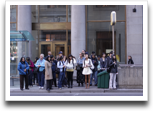
Today, I was browsing through the manual and I discovered, Exposure Lock ("*" button on the back), that can be used when taking panoramas.
If the panorama spans dark and bright regions, the camera re-computes the exposure between successive shots which makes the panorama look unevenly lit when it is stitched. Pressing the "*" button locks the exposure setting and keeping it pressed while panning the camera and shooting, ensures the same exposure is maintained across the entire panorama.Did some night photography on the walk back home. Tried full auto (with flash) and Creative Assist mode (surpressed flash and reduced exposure). I would have to praise the CA mode for allowing those learning to use the camera, to take great pictures. Photos forthcoming. I didn't take as many photos as I would have liked as I wasn't dressed for standing around in 10°C weather.
Found another usability irritant: the CA mode settings reset after photos are reviewed or if the camera is switched to another mode.
This afternoon, I took a 15MP photograph of a student, who was standing in the Atrium, from about 70 feet away; it was pretty impressive that you could zoom in and see she was holding an iPod Touch or iPhone.Verve Photo showcases documentary photographers.
Documentary photography involves telling stories of people, with still pictures (the captions fill-in the details; the photos stand on their own). Photographing people without affecting the emotions in the photograph because of the camera's presence, is an art that cannot be taught.David sent a link to the 50D review. Reading it was helpful as an supplement to the dry user manual.
I noticed that the charger that I got with the body-only kit looks different than the one pictured in the review. I still don't know what the AF-ON button ("The AF-ON button allows you to trigger auto focus independently of the shutter release 'half-press'.") is supposed to do— pressing it seems to focus the lens far and then close in small steps— more reading required. Page 10 of the review has a movie that shows AF operating in LiveView mode. Perhaps it's not working for me because I always have the camera handheld rather than mounted on a tripod or stabilized. Page 17 has an interesting comparison of the sensor noise levels of the various cameras; the Nikon D300 is unexpectedly impressive at ISO1600.
Update Sat Nov 08 12:55:45 2008: After re-reading the LiveView chapter, I have a better understanding of the auto-focus in LiveView mode now and it does work (for some values of "work").
A list of things that I expect to work a certain way, or things that make me wonder why they are a certain way (perhaps later, as I learn the camera, I will understand why) and things that generally bother me about the 50d:
I left the house early this morning so I could take advantage of the beautiful fall weather which, at 6 degrees Celcius, was quite a change from yesterday's high-winds and near-freezing temperatures.
On the walk between home and work, I shot more than 100 photos. I kept my camera in aperture priority at f/1.4 most of the time as an experiment to see how photographs would turn out. I was expecting some accidental surprises from shooting large vistas at f/1.4 but naturally, they all came out blurry.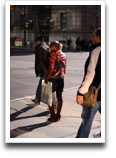 | 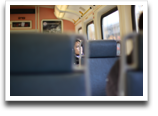 | 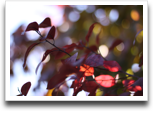 | 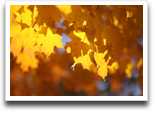 |
Update Sat Nov 01 11:15:32 2008: The fashion shot was the only photo I took, just as the light turned green; the GO Train photo was also a single shot; the red plant was one of eight; the photo of the maple leaves was one of 18. I also increased the LCD brightness to 2 notches above the default, to be able to review photos in direct noon sunlight.
More settings I changed:
The Canon EF 24-70mm f/2.8 L USM is on sale for $1250 at Downtown Camera. Seriously considering getting it (but having second thoughts after only shooting about 100 shots with the 50mm and that the 24-70 weighs nearly a kilogram).
Need to shoot some more downtown landscapes with the 50mm to see its limitations. Maybe I'll just get a 24mm prime used by the backstage photographers featured on Behind the Lens.Quicktime VR of the Beijing Olympics Stadium Press Box, 30 minutes before the 100m finals.
Stickers seem to be popular addition to lens hoods. I can't tell what the most popular camera is (Nikon or Canon). I wonder if the white balance is off as all the telephoto lenses are beige rather than white.Today, I got the opportunity to shoot photographs in the scenario for which the camera and lens was purchased— three kids running around indoors in low light. From the results, I have to say that I LOVE both the Canon 50D and the 50mm lens. The shots came out absolutely amazing (I shot all the close-ups (less that 3 feet) at f/1.4). The only minor complaint I have is that the camera didn't detect the tungsten light and I had to manually correct the white balance setting.
Todo: 1) figure out how to tell the camera to track a subject as it moves through the autofocus points (I remember reading about it but forgot how to do it.) 2) figure out a rule-of-thumb that correlates f-stop to distance from subject and area of the circle that is in focus (e.g. if I am 5 feet away, and I want everything in the frame in focus, what f-stop do I have to dial; alternatively, I could always switch to full-auto or program mode).
I also took some closeups of a lit candle which turned out quite nicely.This morning, I decided to do a study suggested in an article I read last night about understanding the concept of depth of field.
I set-up three objects (a LEGO box, a vase and a LEGO object) in a straight line, each about a foot apart, switched the camera to aperture priority (Av), dropped the f-stop value to the lowest setting (f/1.4), focused on the middle object (the vase) and took a picture. Then, I changed the f-stop to the next highest setting and took a picture, and continued until the maximum f-stop (f/22).Below are three selections of the study: a low f-stop, a higher f-stop and a large f-stop.
This review looks at the three Canon 50mm lenses, el-cheapo, mid-range and high-end; additional review sites are listed at the end.
And of course, there is the famous Zeiss 50 mm f/0.7 lens that Kubrick used to shoot the candle-lit gambling scene in Barry Lyndon, without additional artificial lights.Jim brought in his 75-300mm telephoto lens and I had a lot of fun shooting with it today. He said this lens was purchased in the days before there were digital SLR cameras.
First impressions (I have nothing to compare it to): the lens is great for daytime shooting. I managed a few twilight shots but I found that it had the annoying habit of losing focus completely for no discernable reason (maybe because I was shooting through glass?) which required me to manually recompose/zoom-in and focus again. I was able to read the text on a letter-sized sign (in 48pt font?) from half a block away. I was able to read the text in the photograph; it was too shaky to read-it while shooting hand-held. The best descriptor of the the zoom-ring would have to be, "clunky with a bit of wobble". Update Wed Oct 22 23:51:38 2008: This is not an internal zoom lens; the length of the lens changes as you zoom in, unlike the EF 75-200 mm f/2.8 L IS USM (US$ 1700, that Eric recommends, non IS version US$ 1200).
I was hoping to catch someone undressing in front of their window in the many apartments around the university, or a murder being committed, but no such luck.
Update Fri Oct 24 18:36:20 2008: Photos now available.
Update Fri Oct 24 22:12:23 2008: David suggests some alternatives:
What are you planning on take pictures of?
If you're going to take pictures of objects far away that you need to zoom into, then the 75-200 would be useful (remember to multiple by 1.6x to get the "true" length though).
If a good portion of your pictures will be indoors, or for close- to medium-distance objects, Canon's 24-70mm may be of more use.
There are also 70-200 f/4 lenses (IS and non-IS). Both are about US$ 700 less expensive than their f/2.8 counterparts.
The 50D has a 1.6x crop factor, so your 50 mm lens is acting like an 80 mm one--that's basically a portrait lens.
If you want a lens that has a field of view roughly as wide as your eyes, you would need to get something like the 28mm (f/1.8 available). Multiplying by 1.6, it will act like a 45mm lens; much closer to the "standard" 50 mm view of the old 35 mm film cameras (and current full- frame DSLRs).
If you're planning on doing more wide shots, it may be worth considering getting a wider lens. In a lot of cases it's easier to step in to get a close up than it is to step back to get a wide shot. Also, you can always "zoom in" my simply cropping the picture to get the proper framing that you want. If it's not possible to step back any further you're stuck.
Your eyes have an angle of view that might be as much as 120° (wiggle your fingers off to the side while staring straight ahead to see what I mean). On the other hand, your perception of detail anywhere but straight ahead is atrocious, and then of course there's the "blind spot". So it's meaningless to talk about your eyes' "angle of view".
I'm pretty sure that standard lenses are standard because: the 45° field of view happens (for reasons I don't understand) to be the easiest lens to make so for a given price, the 45°-field-of-view lens is the fastest and has the highest quality.
Lenses have easily-determined fields of view; it's your eyes that don't.
After I got back, I cleared my work counter and while the battery was charging, I read through the manual. After the battery charged (100 minutes to full charge), I had to call my colleague over for help with attaching the neck-strap, as the single diagram showing the procedure was rather cryptic. Fortunately, he is experienced in this, as his wife has a Canon Rebel (film). Next, I tried to open the battery compartment and I gave-up, as I turned to the manual; he calmly reached over, opened it and inserted the battery. I took the 1GB CF card out of my S60 and inserted it into the camera and powered it up. I took a couple of shots and I was quite impressed with the bokeh (photos will be uploaded later). The view-screen is HUGE and AMAZING; it seems to have some sort of optical coating where the oil from one's face that rubs-off on the screen, does not seem to distort the image being viewed.
We had a difficult time configuring the inside of the camera bag using the velcro partitions, to hold the camera. More on this later.
The true test of this camera's capabilities will be in low-light. I tried taking some in my darkened apartment and it had trouble focusing on the far door; it instead kept focusing on a near-wall (I tried manually focusing but the results were blurry; I haven't figured out how to tell it to focus on something else.)
It's easy to take great shots in good light with this camera (in full auto mode). I am now thinking of going professional, hiring an extremely pretty female assistant (interested parties please include a recent photograph with your résumé) to walk around and take readings with a light-meter. Since Toronto Fashion Week starts next week, I wonder where I can get credentials to be able to photograph the models.
Time to watch Blowup again.
Update Thu Oct 16 23:16:43 2008: David suggested getting a Gorillapod.Sun Nov 23 00:25:18 2008
David sent me an article on Magnum's blog with thoughts and suggestions about photography from several Magnum photographers.
Sometimes, one photographer's advice to look at other photographer's work, is contradicted by another who prefers to not be influenced by others; I suppose it's up to each of us to decide.
I liked Constantine Manos' advice, "... show us something we have never seen before and will never see again." I would like to think that the "Fantastic Foursome" photograph, above, was inspired by this philosophy.